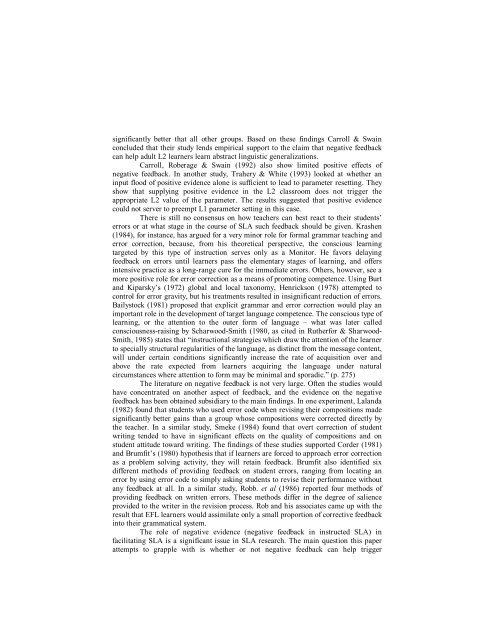language and literature european landmarks of identity
language and literature european landmarks of identity
language and literature european landmarks of identity
You also want an ePaper? Increase the reach of your titles
YUMPU automatically turns print PDFs into web optimized ePapers that Google loves.
significantly better that all other groups. Based on these findings Carroll & Swain<br />
concluded that their study lends empirical support to the claim that negative feedback<br />
can help adult L2 learners learn abstract linguistic generalizations.<br />
Carroll, Roberage & Swain (1992) also show limited positive effects <strong>of</strong><br />
negative feedback. In another study, Trahery & White (1993) looked at whether an<br />
input flood <strong>of</strong> positive evidence alone is sufficient to lead to parameter resetting. They<br />
show that supplying positive evidence in the L2 classroom does not trigger the<br />
appropriate L2 value <strong>of</strong> the parameter. The results suggested that positive evidence<br />
could not server to preempt L1 parameter setting in this case.<br />
There is still no consensus on how teachers can best react to their students’<br />
errors or at what stage in the course <strong>of</strong> SLA such feedback should be given. Krashen<br />
(1984), for instance, has argued for a very minor role for formal grammar teaching <strong>and</strong><br />
error correction, because, from his theoretical perspective, the conscious learning<br />
targeted by this type <strong>of</strong> instruction serves only as a Monitor. He favors delaying<br />
feedback on errors until learners pass the elementary stages <strong>of</strong> learning, <strong>and</strong> <strong>of</strong>fers<br />
intensive practice as a long-range cure for the immediate errors. Others, however, see a<br />
more positive role for error correction as a means <strong>of</strong> promoting competence. Using Burt<br />
<strong>and</strong> Kiparsky’s (1972) global <strong>and</strong> local taxonomy, Henrickson (1978) attempted to<br />
control for error gravity, but his treatments resulted in insignificant reduction <strong>of</strong> errors.<br />
Bailystock (1981) proposed that explicit grammar <strong>and</strong> error correction would play an<br />
important role in the development <strong>of</strong> target <strong>language</strong> competence. The conscious type <strong>of</strong><br />
learning, or the attention to the outer form <strong>of</strong> <strong>language</strong> – what was later called<br />
consciousness-raising by Scharwood-Smith (1980, as cited in Rutherfor & Sharwood-<br />
Smith, 1985) states that “instructional strategies which draw the attention <strong>of</strong> the learner<br />
to specially structural regularities <strong>of</strong> the <strong>language</strong>, as distinct from the message content,<br />
will under certain conditions significantly increase the rate <strong>of</strong> acquisition over <strong>and</strong><br />
above the rate expected from learners acquiring the <strong>language</strong> under natural<br />
circumstances where attention to form may be minimal <strong>and</strong> sporadic.” (p. 275)<br />
The <strong>literature</strong> on negative feedback is not very large. Often the studies would<br />
have concentrated on another aspect <strong>of</strong> feedback, <strong>and</strong> the evidence on the negative<br />
feedback has been obtained subsidiary to the main findings. In one experiment, Lal<strong>and</strong>a<br />
(1982) found that students who used error code when revising their compositions made<br />
significantly better gains than a group whose compositions were corrected directly by<br />
the teacher. In a similar study, Smeke (1984) found that overt correction <strong>of</strong> student<br />
writing tended to have in significant effects on the quality <strong>of</strong> compositions <strong>and</strong> on<br />
student attitude toward writing. The findings <strong>of</strong> these studies supported Corder (1981)<br />
<strong>and</strong> Brumfit’s (1980) hypothesis that if learners are forced to approach error correction<br />
as a problem solving activity, they will retain feedback. Brumfit also identified six<br />
different methods <strong>of</strong> providing feedback on student errors, ranging from locating an<br />
error by using error code to simply asking students to revise their performance without<br />
any feedback at all. In a similar study, Robb. et al (1986) reported four methods <strong>of</strong><br />
providing feedback on written errors. These methods differ in the degree <strong>of</strong> salience<br />
provided to the writer in the revision process. Rob <strong>and</strong> his associates came up with the<br />
result that EFL learners would assimilate only a small proportion <strong>of</strong> corrective feedback<br />
into their grammatical system.<br />
The role <strong>of</strong> negative evidence (negative feedback in instructed SLA) in<br />
facilitating SLA is a significant issue in SLA research. The main question this paper<br />
attempts to grapple with is whether or not negative feedback can help trigger


